Is it a Robe? Is it a Jacket? It’s a Kimono! (Part 3)
So far, our examination has encompassed a diverse array of kimono
Kimono: (Japanese: ki : wearing, mono: thing, Singular: Kimono) A traditional Japanese long loose robe with wide sleeves tied with a sash around the waist. Presently it is the national dress of Japan. types that have pervaded Japanese society, ranging from its antecedents such as the (junihitoe) and (kosode
Kosode: (Japanese: small sleeve or opening), a traditional Japanese inner robe for both genders. Similar to a kimono but with a wider body, longer collars, and narrower and rounded sleeves, often stitched to the body, these under robes were lavishly decorated and were worn on top from late 16th century. ) to its contemporary iterations and assorted variations. However, it is imperative to acknowledge that our investigation has merely scratched the surface of this multifaceted subject. Employing an analogy of a department store, our inquiry has thus far been confined to the "women's section," but it is crucial to bear in mind that a store offers a far broader array of offerings than this single facet. For instance, although comparatively smaller, the "men's section" constitutes a reservoir of rich insights in its own right. Furthermore, we must not overlook the exploration of the "accessories section," as it harbours additional layers of significance within the broader tapestry
Tapestry: wall hanging or other large piece of fabric that is woven in coloured weft threads or embroidered with a decorative design. Typically made of wool, but they can also be made of other materials such as silk, linen, or cotton. Often used to decorate homes, churches, and other buildings. of kimono
Kimono: (Japanese: ki : wearing, mono: thing, Singular: Kimono) A traditional Japanese long loose robe with wide sleeves tied with a sash around the waist. Presently it is the national dress of Japan. culture. Irotomesode:
This is one of the two types of ‘tomesode’ style kimonos –coloured and black. This is distinguished from its counterpart by its coloured – ‘iro’ – base. As exquisite formal kimonos that are primarily worn by married women these kimonos feature short sleeves and are adorned with an elegant continuous eba pattern, similar to a (huomongi). Its characteristic feature that sets it apart from a huomongi is its pattern that gracefully cascades diagonally along the lower section of the garment, spanning over the seams. Traditionally since the Edo period once a young woman transitioned into adulthood – married – the sleeves of her (furisode) kimonos underwent a transformation. These sleeves were meticulously shortened, secured and finished through stitching. Intriguingly, the Japanese verb ‘kiru’ – to cut – carries the inauspicious connotation of "breaking off a relationship." Consequently, this alteration was euphemistically referred to by using the verb ‘tomeru’ – to fasten – ultimately giving rise to the term ’tomesode.’ Originally a ‘tomesode’ was donned by all adult women irrespective of their marital status. However, with time, it became predominantly associated with married women only. This shift was motivated by the practicality of shorter sleeves for household chores, as well as the fact that married women no longer needed the long kimono
Kimono: (Japanese: ki : wearing, mono: thing, Singular: Kimono) A traditional Japanese long loose robe with wide sleeves tied with a sash around the waist. Presently it is the national dress of Japan. sleeves to convey their romantic inclinations. Since it was originally fashioned from furisode_kimonos, irotomesode initially exhibited a wide array of colours and patterns. However, during the Edo period, a new trend emerged that featured designs placed along the rear hem of the kimono
Kimono: (Japanese: ki : wearing, mono: thing, Singular: Kimono) A traditional Japanese long loose robe with wide sleeves tied with a sash around the waist. Presently it is the national dress of Japan. . This distinctive design placement was subsequently adopted for tomesode, refining their aesthetic appeal. The “rationale” underpinning this minimalist stylistic approach, as well as the deliberate concentration of patterns in proximity to the hem of the attire, will be discussed subsequently. It is imperative to note that these kimonos customarily bear the familial crest of the wearer, serving as a definitive marker of their elevated formality and status. The degree of formality associated with the irotomesode is contingent upon the number of family crests adorning it, thus determining its appropriateness for various occasions. Specifically, when adorned with five crests, the irotomesode attains the significantly high level of formality possible, while with three crests, it becomes suitable for semi-formal events, whereas a single crest designates it as fitting attire for more informal gatherings, such as entrance and graduation ceremonies. However, in contrast to its counterpart – the (kurotomesode) – the irotomesode offers a broader spectrum of versatility and is not exclusively reserved for married women. In social contexts like weddings and receptions, individuals other than the bride and groom's mothers may opt for an irotomesode featuring five crests, while other attendees might select versions adorned with one to three crests. Moreover, the irotomesode finds its place in formal gatherings, ceremonies for the bestowal of honours, and visits to the Imperial Palace. Kuromesode:
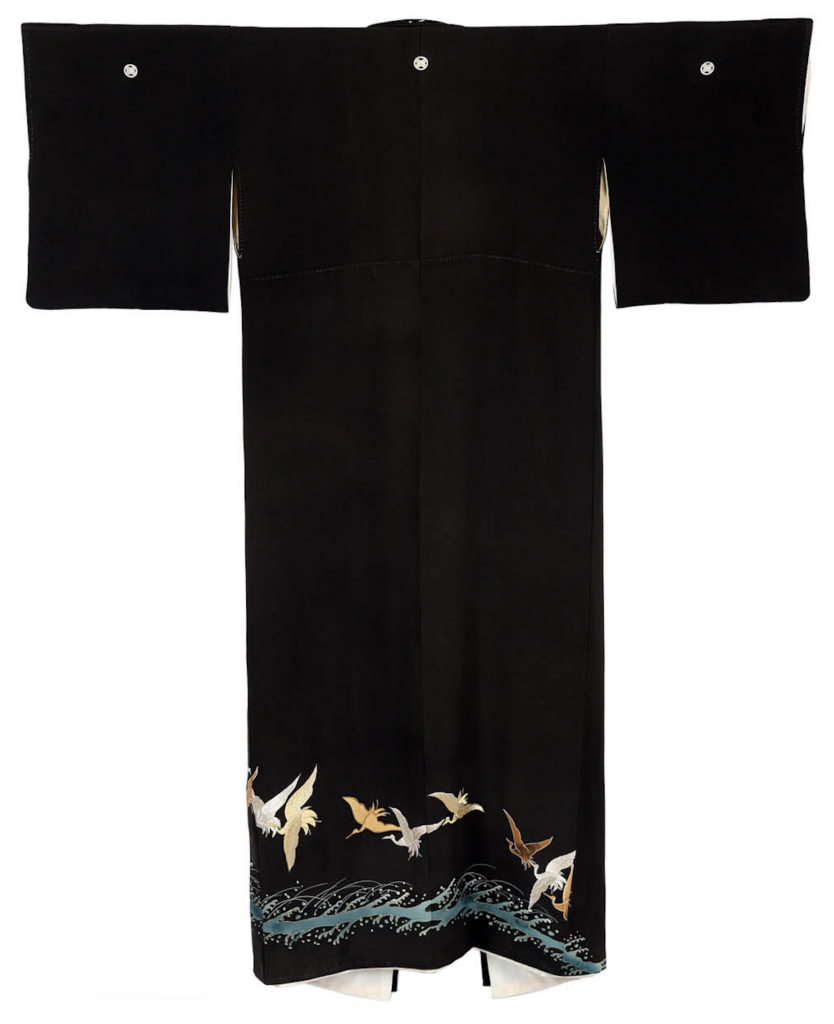 Front and back of a kurotomesode style kimono
Kimono: (Japanese: ki : wearing, mono: thing, Singular: Kimono) A traditional Japanese long loose robe with wide sleeves tied with a sash around the waist. Presently it is the national dress of Japan. ; “Silk embroidered women’s robe”, c. 20th century, Japan; Acc No: ZI2017.500484 ASIA, The Zay
Zay: (Arabic: costume, Pl. azyaā’), a set of clothes in a style typical of a particular country or historical period. Initiative, LINK
Front and back of a kurotomesode style kimono
Kimono: (Japanese: ki : wearing, mono: thing, Singular: Kimono) A traditional Japanese long loose robe with wide sleeves tied with a sash around the waist. Presently it is the national dress of Japan. ; “Silk embroidered women’s robe”, c. 20th century, Japan; Acc No: ZI2017.500484 ASIA, The Zay
Zay: (Arabic: costume, Pl. azyaā’), a set of clothes in a style typical of a particular country or historical period. Initiative, LINK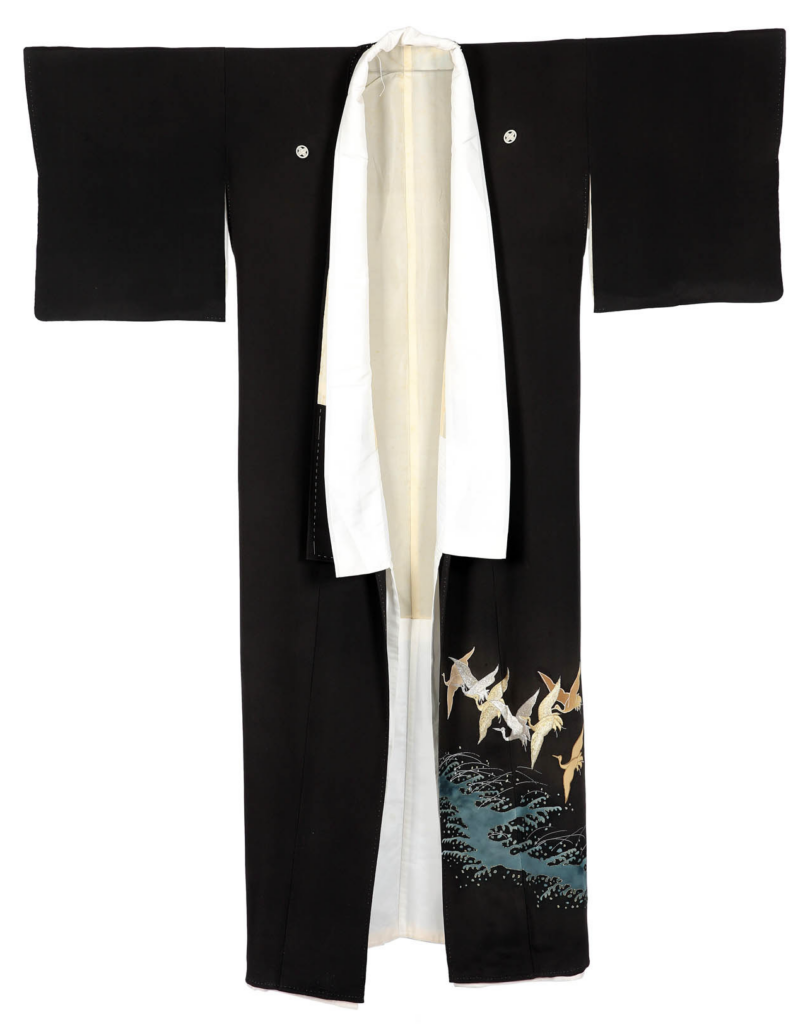 Front and back of a kurotomesode style kimono
Kimono: (Japanese: ki : wearing, mono: thing, Singular: Kimono) A traditional Japanese long loose robe with wide sleeves tied with a sash around the waist. Presently it is the national dress of Japan. ; “Silk embroidered women’s robe”, c. 20th century, Japan; Acc No: ZI2017.500484 ASIA, The Zay
Zay: (Arabic: costume, Pl. azyaā’), a set of clothes in a style typical of a particular country or historical period. Initiative, LINKThe other type of ‘tomesode’ style of kimono
Kimono: (Japanese: ki : wearing, mono: thing, Singular: Kimono) A traditional Japanese long loose robe with wide sleeves tied with a sash around the waist. Presently it is the national dress of Japan. is the ‘kuro’ or black ‘tomesode’. The selection of black as the foundational hue for the kurotomesode was likely transpired during the Meiji period – 1868-1912 – and was notably influenced by Western formal attire. The kurotomesode, regarded as the apex of formality among kimonos for married women, finds its exclusive usage during matrimonial rites and ceremonial receptions, primarily donned by immediate family members of the marrying couple. Distinguished by the presence of five family crests, the kurotomesode boasts intricate patterns adorned with opulent gold leaf and embroidery. These embellishments are imbued with auspicious symbolism, conveying wishes for profound joy and enduring happiness. Nonetheless, even though the kurotomesode holds formal significance within the Japanese society, it is not permissible within the Imperial Palace as black symbolizes mourning. Instead, the irotomesode is the preferred choice. When a ‘tomesode’ is worn by a member of the Imperial family or when an ordinary individual visits the Imperial Palace for events such as order bestowals, adhering to convention dictates the selection of the irotomesode.
Front and back of a kurotomesode style kimono
Kimono: (Japanese: ki : wearing, mono: thing, Singular: Kimono) A traditional Japanese long loose robe with wide sleeves tied with a sash around the waist. Presently it is the national dress of Japan. ; “Silk embroidered women’s robe”, c. 20th century, Japan; Acc No: ZI2017.500484 ASIA, The Zay
Zay: (Arabic: costume, Pl. azyaā’), a set of clothes in a style typical of a particular country or historical period. Initiative, LINKThe other type of ‘tomesode’ style of kimono
Kimono: (Japanese: ki : wearing, mono: thing, Singular: Kimono) A traditional Japanese long loose robe with wide sleeves tied with a sash around the waist. Presently it is the national dress of Japan. is the ‘kuro’ or black ‘tomesode’. The selection of black as the foundational hue for the kurotomesode was likely transpired during the Meiji period – 1868-1912 – and was notably influenced by Western formal attire. The kurotomesode, regarded as the apex of formality among kimonos for married women, finds its exclusive usage during matrimonial rites and ceremonial receptions, primarily donned by immediate family members of the marrying couple. Distinguished by the presence of five family crests, the kurotomesode boasts intricate patterns adorned with opulent gold leaf and embroidery. These embellishments are imbued with auspicious symbolism, conveying wishes for profound joy and enduring happiness. Nonetheless, even though the kurotomesode holds formal significance within the Japanese society, it is not permissible within the Imperial Palace as black symbolizes mourning. Instead, the irotomesode is the preferred choice. When a ‘tomesode’ is worn by a member of the Imperial family or when an ordinary individual visits the Imperial Palace for events such as order bestowals, adhering to convention dictates the selection of the irotomesode. The “Rationale”:
The evolution of the kimono
Kimono: (Japanese: ki : wearing, mono: thing, Singular: Kimono) A traditional Japanese long loose robe with wide sleeves tied with a sash around the waist. Presently it is the national dress of Japan. serves as a compelling illustration of the profound interplay between changing fashion trends and societal dynamics. Fashion, at times, is relegated to a seemingly peripheral role within the broader context of society and culture. Nevertheless, the design and transformation of the kimono
Kimono: (Japanese: ki : wearing, mono: thing, Singular: Kimono) A traditional Japanese long loose robe with wide sleeves tied with a sash around the waist. Presently it is the national dress of Japan. consistently underscore the limitations of such a perspective in comprehending this continually evolving facet of human history. For instance, the progression, or rather the assimilation, of the prevailing trend involving the concentration of patterns near the hem of the tomesode kimono
Kimono: (Japanese: ki : wearing, mono: thing, Singular: Kimono) A traditional Japanese long loose robe with wide sleeves tied with a sash around the waist. Presently it is the national dress of Japan. stems from profound societal disruptions. Prior to the year 1707 CE, Japanese fashion flourished in an era of opulence, marked by peace and prosperity during the Genroku period. However, with the cataclysmic eruption of Mount Fuji in 1707 CE, Japan entered a period characterized by a succession of natural calamities, including fires, floods, earthquakes, devastating plagues, and famine. These adversities wrought havoc on the nation's rice-based economy, previously stable and flourishing. The feudal lords, known as daimyo, were already burdened by substantial debts owed to merchants and other financiers, who had funded their extravagant lifestyles. Consequently, when calamities struck, these merchants emerged as profiteers, occupying one extreme of the socioeconomic spectrum, while the samurai or the warrior class, found themselves amongst the most severely affected. Samurai, once relied upon to maintain a respectable standard of living through their service to the feudal lords, now struggled to make ends meet. This predicament eroded the samurai community's faith and loyalty toward their lords, prompting some pragmatically inclined individuals to seek alternative employment. Efforts to alleviate this dire state of affairs prompted successive emperors from the Tokugawa clan to enact numerous edicts spanning generations, aimed at curbing extravagant lifestyles. These edicts encompassed various aspects of daily life, from regulating the number of palanquins permitted at weddings to implementing sumptuary laws. Over time, the proliferation of such edicts reached a point where societal adherence began to wane, leading to a period between c. 1804 and 1830 when fashion was characterized as gaudy, ostentatious, and flamboyant in the later years. Despite the continuous issuance of reforms and edicts, substantive societal changes remained elusive until cotton emerged as a transformative element. The sumptuary edicts of the era, which sought to minimize ostentatious designs on fabrics, coincided with cotton's rising popularity in fashion. Unlike silk, cotton complemented smaller patterns, narrower stripes, and pictorial embellishments executed through simpler techniques far more effectively than lavish and ornate designs. In some instances, these pictorial motifs were confined to areas near the hem of the kimono
Kimono: (Japanese: ki : wearing, mono: thing, Singular: Kimono) A traditional Japanese long loose robe with wide sleeves tied with a sash around the waist. Presently it is the national dress of Japan. , a preference notably embraced by the geisha community. This phenomenon culminated in the distinctive sobriety characteristic of the modern tomesode kimonos, marked by a palette of colours predominantly in shades of blue, brown, and grey. Tsukesaga:
The (tsukesage) kimonos find favour amongst both married and unmarried women, representing a versatile attire option. While they may be perceived as less prestigious in comparison to the huomongi, their status can vary based on the chosen accessories and patterns. Typically, tsukesage patterns exhibit modest dimensions, characterized by smaller motifs thoughtfully arranged across the garment's hem, sleeves, (yoke
Yoke: (Synonym: Bodice_Yoke), a structured pattern fitted at the shoulders defining the structure of women’s garments. Introduced in c. 1880s it defines the transition between the upper and lower parts of the garments and can now be found stitched-in where the blouse is separated from the skirt by a horizontal seam. ), and shoulders. Differing from the huomongi, the tsukesage patterns are generally not aligned along the seamlines. Even when an eba style distribution is followed, it is intentionally designed to convey a sense of modesty relative to huomongi or tomesodes. An additional distinguishing factor is that the tsukesage kimonos are initially dyed and sold as tanmono – traditional Japanese narrow-loomed cloth used for kimono
Kimono: (Japanese: ki : wearing, mono: thing, Singular: Kimono) A traditional Japanese long loose robe with wide sleeves tied with a sash around the waist. Presently it is the national dress of Japan. production. Subsequently, they are tailored to individual measurements, whereas huomongi kimonos are dyed after the cloth pieces have been cut and are typically temporarily stitched for display at kimono
Kimono: (Japanese: ki : wearing, mono: thing, Singular: Kimono) A traditional Japanese long loose robe with wide sleeves tied with a sash around the waist. Presently it is the national dress of Japan. shops. Tsukesage kimonos are well-suited for a range of occasions, including children's graduation ceremonies, intimate gatherings and reunions, semi-formal tea parties, visits to clients' residences, attendance at theatrical performances like kabuki – Japanese traditional theatre – plays, and other semi-formal events. Interestingly the style emerged as a less formal alternative to the huomongi during the Taisho and early Showa periods. Its popularity solidified during the Pacific War – 1941-1945 – when opulent huomongi and other luxurious and expensive kimonos were prohibited. In fact, such prohibitions were reinforced through propaganda advocating that "luxury is the enemy," discouraging the pursuit of lavish lifestyles during challenging times. Hikizuri:
Prior to the Meiji era – 1868-1912 – the (hikizuri) kimono
Kimono: (Japanese: ki : wearing, mono: thing, Singular: Kimono) A traditional Japanese long loose robe with wide sleeves tied with a sash around the waist. Presently it is the national dress of Japan. was exclusively worn by affluent women of high social standing. Presently, the likelihood of encountering this particular kimono
Kimono: (Japanese: ki : wearing, mono: thing, Singular: Kimono) A traditional Japanese long loose robe with wide sleeves tied with a sash around the waist. Presently it is the national dress of Japan. style in public settings is exceedingly low, except in locales such as Kyoto or the Asakusa district of Tokyo. The nomenclature hikizuri translates to "trailing skirt," a name befitting its distinctive length, which allows the sumptuous fabric to gracefully cascade. In sharp contrast to other forms of kimonos, the hikizuri is predominantly reserved for geishas, maikos, or individuals engaged in traditional Japanese dance performances. The evolution of contemporary society has broadened women's opportunities to engage beyond the confines of their homes, necessitating the adaptation of prevailing kimono
Kimono: (Japanese: ki : wearing, mono: thing, Singular: Kimono) A traditional Japanese long loose robe with wide sleeves tied with a sash around the waist. Presently it is the national dress of Japan. styles. Consequently, contemporary kimono
Kimono: (Japanese: ki : wearing, mono: thing, Singular: Kimono) A traditional Japanese long loose robe with wide sleeves tied with a sash around the waist. Presently it is the national dress of Japan. styles have incorporated techniques for neatly folding excess fabric around the waist, in contrast to the opulent and trailing design of the hikizuri kimono
Kimono: (Japanese: ki : wearing, mono: thing, Singular: Kimono) A traditional Japanese long loose robe with wide sleeves tied with a sash around the waist. Presently it is the national dress of Japan. .Iromuji:
An (iromuji) refers to a type of kimono
Kimono: (Japanese: ki : wearing, mono: thing, Singular: Kimono) A traditional Japanese long loose robe with wide sleeves tied with a sash around the waist. Presently it is the national dress of Japan. that is monochromatic in colour, excluding black and white, and lacks any printed patterns or embroidered motifs. An iromuji kimono
Kimono: (Japanese: ki : wearing, mono: thing, Singular: Kimono) A traditional Japanese long loose robe with wide sleeves tied with a sash around the waist. Presently it is the national dress of Japan. may exhibit a uniform hue or incorporate woven patterns within the fabric, thereby exhibiting a simple and unadorned aesthetic. Its primary association lies with traditional tea parties and tea ceremonies; however, its versatility extends to various formal, semi-formal, and casual occasions, contingent upon factors such as the presence of family crests, choice of accessories, and colour palette. In the realm of formal attire, an iromuji featuring vibrant colours, such as pink or yellow, with auspicious fabric weaves are deemed appropriate attire for events like weddings, tea ceremonies, coming-of-age celebrations, entrance or graduation ceremonies. Conversely, an iromuji in solid, neutral shades like dark blue or grey are considered suitable for sombre occasions such as wakes and funerals. In more relaxed settings, where an iromuji serves as everyday wear for casual gatherings and dinners with friends, individuals have the liberty to experiment with accessories. This includes the option to select elaborate and fashionable sashes or (obi
Obi: (Japanese), a wide, decorative belt or sash traditionally worn with Japanese kimono. It wraps around the waist, securing the kimono and adding an elegant touch to the attire. They are often intricately designed, featuring rich patterns, textures, and colors that complement the overall kimono ensemble. ) devoid of gold and silver embellishments, thereby creating a delightful contrast with the plain kimono
Kimono: (Japanese: ki : wearing, mono: thing, Singular: Kimono) A traditional Japanese long loose robe with wide sleeves tied with a sash around the waist. Presently it is the national dress of Japan. . Alternatively, one can opt for a tone-on-tone ensemble, aligning the obi
Obi: (Japanese), a wide, decorative belt or sash traditionally worn with Japanese kimono. It wraps around the waist, securing the kimono and adding an elegant touch to the attire. They are often intricately designed, featuring rich patterns, textures, and colors that complement the overall kimono ensemble. and kimono
Kimono: (Japanese: ki : wearing, mono: thing, Singular: Kimono) A traditional Japanese long loose robe with wide sleeves tied with a sash around the waist. Presently it is the national dress of Japan. hues to fashion a refined and playful appearance. Yosegire:
The emergence of the(yosegire) kimono
Kimono: (Japanese: ki : wearing, mono: thing, Singular: Kimono) A traditional Japanese long loose robe with wide sleeves tied with a sash around the waist. Presently it is the national dress of Japan. as a fashionable attire during the Edo Period – 1603-1867 CE – was precipitated by the imposition of stringent sumptuary laws, which sought to curtail the utilization of expensive silk and opulent fabrics. However, the concurrent economic development, characterized by the ascension of a prosperous merchant class, laid the foundation for the evolution of this distinctive kimono
Kimono: (Japanese: ki : wearing, mono: thing, Singular: Kimono) A traditional Japanese long loose robe with wide sleeves tied with a sash around the waist. Presently it is the national dress of Japan. type. 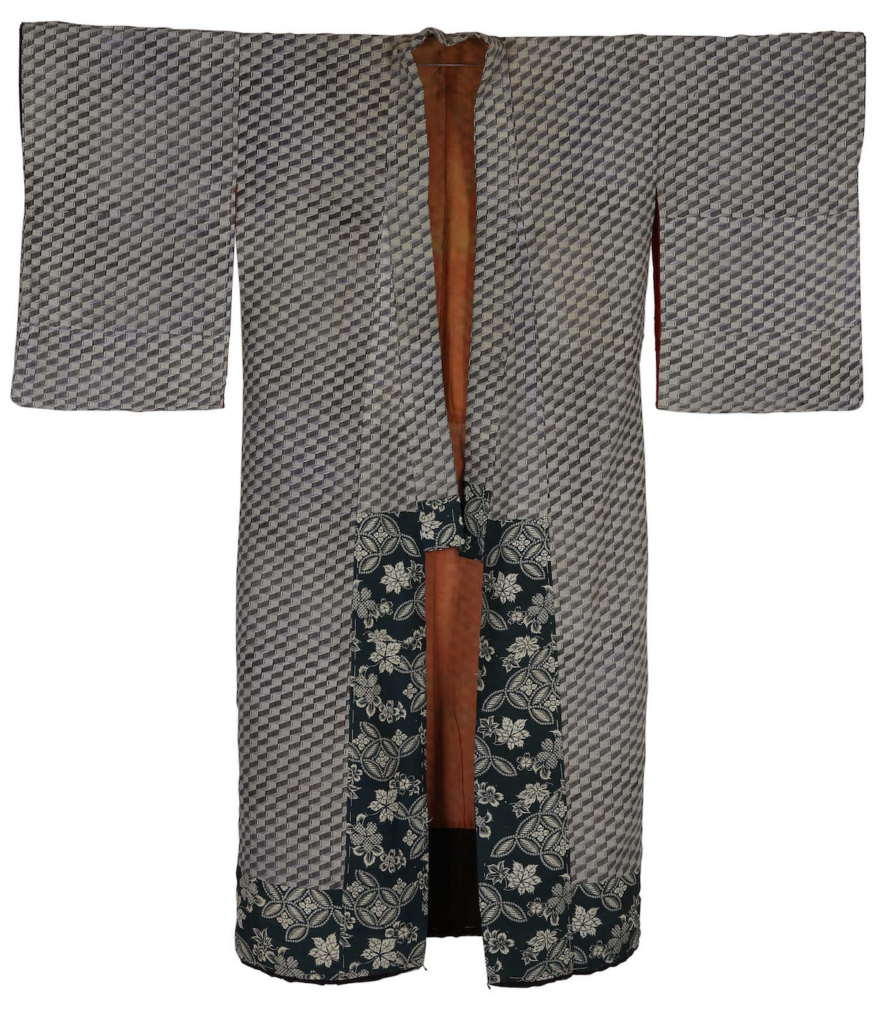 Front and back of a yosegire style kimono
Kimono: (Japanese: ki : wearing, mono: thing, Singular: Kimono) A traditional Japanese long loose robe with wide sleeves tied with a sash around the waist. Presently it is the national dress of Japan. ; “Silk and cotton patchwork women’s robe”, c. 19th -20th century, Japan; Acc No: ZI2017.500837 ASIA, The Zay
Zay: (Arabic: costume, Pl. azyaā’), a set of clothes in a style typical of a particular country or historical period. Initiative, LINK
Front and back of a yosegire style kimono
Kimono: (Japanese: ki : wearing, mono: thing, Singular: Kimono) A traditional Japanese long loose robe with wide sleeves tied with a sash around the waist. Presently it is the national dress of Japan. ; “Silk and cotton patchwork women’s robe”, c. 19th -20th century, Japan; Acc No: ZI2017.500837 ASIA, The Zay
Zay: (Arabic: costume, Pl. azyaā’), a set of clothes in a style typical of a particular country or historical period. Initiative, LINK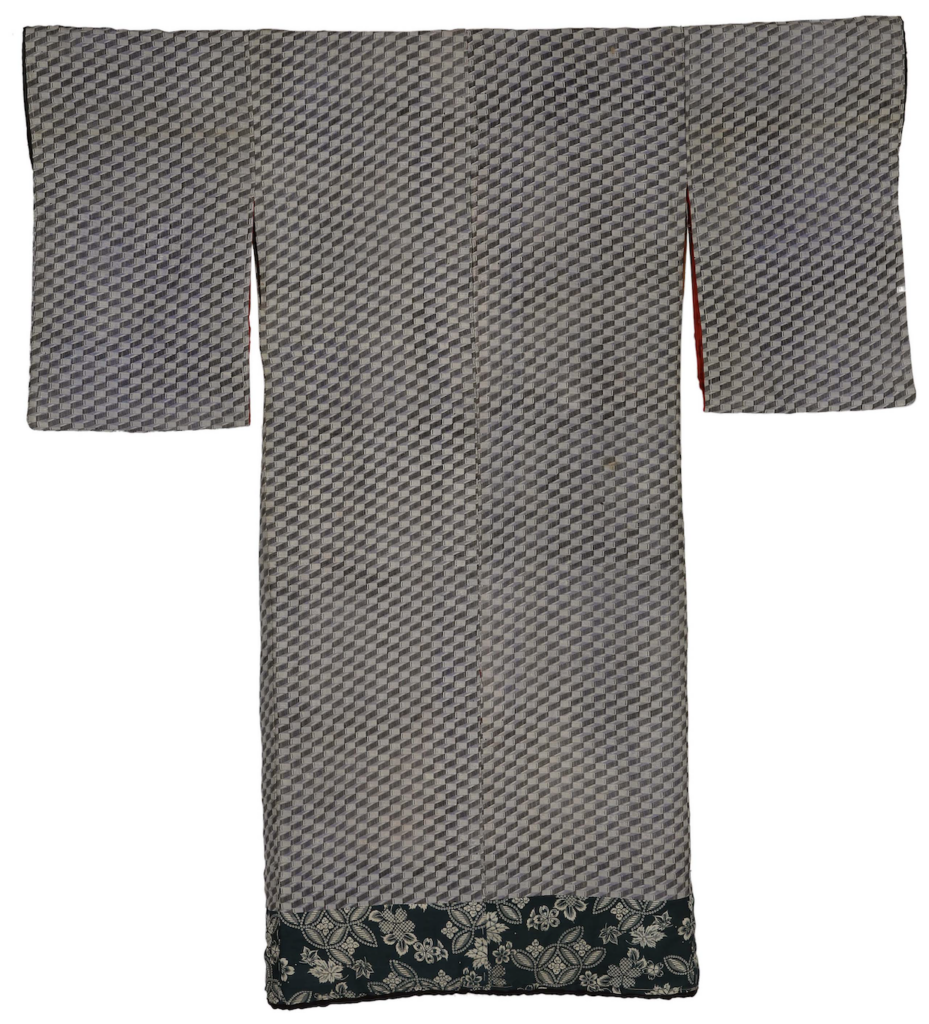 Front and back of a yosegire style kimono
Kimono: (Japanese: ki : wearing, mono: thing, Singular: Kimono) A traditional Japanese long loose robe with wide sleeves tied with a sash around the waist. Presently it is the national dress of Japan. ; “Silk and cotton patchwork women’s robe”, c. 19th -20th century, Japan; Acc No: ZI2017.500837 ASIA, The Zay
Zay: (Arabic: costume, Pl. azyaā’), a set of clothes in a style typical of a particular country or historical period. Initiative, LINKIn essence, a yosegire kimono
Kimono: (Japanese: ki : wearing, mono: thing, Singular: Kimono) A traditional Japanese long loose robe with wide sleeves tied with a sash around the waist. Presently it is the national dress of Japan. is a garment formed by assembling two or more different fabrics of materials such as cotton, linen, and silk, in varying combinations. The utilization of patchwork techniques, once primarily associated with impoverished farmers, experienced a conspicuous surge in popularity among the affluent merchant class as well. Initially conceived as a means to preserve and extend the utility of valuable textiles, the yosegire kimono
Kimono: (Japanese: ki : wearing, mono: thing, Singular: Kimono) A traditional Japanese long loose robe with wide sleeves tied with a sash around the waist. Presently it is the national dress of Japan. evolved into a fashionable favourite, particularly amongst women belonging to the newly affluent strata of 19th century Japanese society. In fact, the term yosegire originally refers to the art of patchwork a trend that extended beyond the realm of kimonos, encompassing the creation of household decorative items such as screens and furniture covers, thus epitomizing the multifaceted utilization of this innovative craft. Consequently, we have reached the conclusion of yet another segment in the exploration of this intricate garment, delving into its historical trajectory and evolutionary course.
Front and back of a yosegire style kimono
Kimono: (Japanese: ki : wearing, mono: thing, Singular: Kimono) A traditional Japanese long loose robe with wide sleeves tied with a sash around the waist. Presently it is the national dress of Japan. ; “Silk and cotton patchwork women’s robe”, c. 19th -20th century, Japan; Acc No: ZI2017.500837 ASIA, The Zay
Zay: (Arabic: costume, Pl. azyaā’), a set of clothes in a style typical of a particular country or historical period. Initiative, LINKIn essence, a yosegire kimono
Kimono: (Japanese: ki : wearing, mono: thing, Singular: Kimono) A traditional Japanese long loose robe with wide sleeves tied with a sash around the waist. Presently it is the national dress of Japan. is a garment formed by assembling two or more different fabrics of materials such as cotton, linen, and silk, in varying combinations. The utilization of patchwork techniques, once primarily associated with impoverished farmers, experienced a conspicuous surge in popularity among the affluent merchant class as well. Initially conceived as a means to preserve and extend the utility of valuable textiles, the yosegire kimono
Kimono: (Japanese: ki : wearing, mono: thing, Singular: Kimono) A traditional Japanese long loose robe with wide sleeves tied with a sash around the waist. Presently it is the national dress of Japan. evolved into a fashionable favourite, particularly amongst women belonging to the newly affluent strata of 19th century Japanese society. In fact, the term yosegire originally refers to the art of patchwork a trend that extended beyond the realm of kimonos, encompassing the creation of household decorative items such as screens and furniture covers, thus epitomizing the multifaceted utilization of this innovative craft. Consequently, we have reached the conclusion of yet another segment in the exploration of this intricate garment, delving into its historical trajectory and evolutionary course. Share
Leave a comment




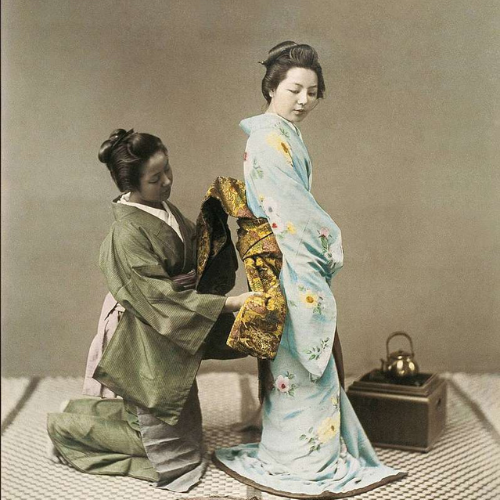
 Front and back of a kurotomesode style kimono
Kimono: (Japanese: ki : wearing, mono: thing, Singular: Kimono) A traditional Japanese long loose robe with wide sleeves tied with a sash around the waist. Presently it is the national dress of Japan. ; “Silk embroidered women’s robe”, c. 20th century, Japan; Acc No: ZI2017.500484 ASIA, The Zay
Zay: (Arabic: costume, Pl. azyaā’), a set of clothes in a style typical of a particular country or historical period. Initiative, LINK
Front and back of a kurotomesode style kimono
Kimono: (Japanese: ki : wearing, mono: thing, Singular: Kimono) A traditional Japanese long loose robe with wide sleeves tied with a sash around the waist. Presently it is the national dress of Japan. ; “Silk embroidered women’s robe”, c. 20th century, Japan; Acc No: ZI2017.500484 ASIA, The Zay
Zay: (Arabic: costume, Pl. azyaā’), a set of clothes in a style typical of a particular country or historical period. Initiative, LINK Front and back of a kurotomesode style kimono
Kimono: (Japanese: ki : wearing, mono: thing, Singular: Kimono) A traditional Japanese long loose robe with wide sleeves tied with a sash around the waist. Presently it is the national dress of Japan. ; “Silk embroidered women’s robe”, c. 20th century, Japan; Acc No: ZI2017.500484 ASIA, The Zay
Zay: (Arabic: costume, Pl. azyaā’), a set of clothes in a style typical of a particular country or historical period. Initiative, LINK
Front and back of a kurotomesode style kimono
Kimono: (Japanese: ki : wearing, mono: thing, Singular: Kimono) A traditional Japanese long loose robe with wide sleeves tied with a sash around the waist. Presently it is the national dress of Japan. ; “Silk embroidered women’s robe”, c. 20th century, Japan; Acc No: ZI2017.500484 ASIA, The Zay
Zay: (Arabic: costume, Pl. azyaā’), a set of clothes in a style typical of a particular country or historical period. Initiative, LINK Front and back of a yosegire style kimono
Kimono: (Japanese: ki : wearing, mono: thing, Singular: Kimono) A traditional Japanese long loose robe with wide sleeves tied with a sash around the waist. Presently it is the national dress of Japan. ; “Silk and cotton patchwork women’s robe”, c. 19th -20th century, Japan; Acc No: ZI2017.500837 ASIA, The Zay
Zay: (Arabic: costume, Pl. azyaā’), a set of clothes in a style typical of a particular country or historical period. Initiative, LINK
Front and back of a yosegire style kimono
Kimono: (Japanese: ki : wearing, mono: thing, Singular: Kimono) A traditional Japanese long loose robe with wide sleeves tied with a sash around the waist. Presently it is the national dress of Japan. ; “Silk and cotton patchwork women’s robe”, c. 19th -20th century, Japan; Acc No: ZI2017.500837 ASIA, The Zay
Zay: (Arabic: costume, Pl. azyaā’), a set of clothes in a style typical of a particular country or historical period. Initiative, LINK Front and back of a yosegire style kimono
Kimono: (Japanese: ki : wearing, mono: thing, Singular: Kimono) A traditional Japanese long loose robe with wide sleeves tied with a sash around the waist. Presently it is the national dress of Japan. ; “Silk and cotton patchwork women’s robe”, c. 19th -20th century, Japan; Acc No: ZI2017.500837 ASIA, The Zay
Zay: (Arabic: costume, Pl. azyaā’), a set of clothes in a style typical of a particular country or historical period. Initiative, LINK
Front and back of a yosegire style kimono
Kimono: (Japanese: ki : wearing, mono: thing, Singular: Kimono) A traditional Japanese long loose robe with wide sleeves tied with a sash around the waist. Presently it is the national dress of Japan. ; “Silk and cotton patchwork women’s robe”, c. 19th -20th century, Japan; Acc No: ZI2017.500837 ASIA, The Zay
Zay: (Arabic: costume, Pl. azyaā’), a set of clothes in a style typical of a particular country or historical period. Initiative, LINK